|
|
|
Zermatt in the winter - ski holiday par excellenceSki holiday in Zermatt - More than only skiing and snowboarding 
While in the summer season in Zermatt, thousands of hikers and mountain climbers as also Matterhorn - onlookers are carvoting, in the winter season, Zermatt is visited by skiers and snowboarders from all over the world. Finally, Zermatt has a huge skiing area that additionally is at the bottom of the most famous mountain of the world. While I have in my Zermatt-pages a lot of single pages about the most different mountain ranges and regions of the Zermatt area but the winter page only consists on one page, this is due to the fact that all the beauties that can be discovered and accessed for hiking in the summer time in the mountains of Zermatt, disappear in the winter time under a snow cover. What in the summer time is a fabulous coloured mix of green forests and meadows, idyllic lakes, mighty glaciers and majestic mountains, is in the winter time a huge white surface, but this has also attractions. Life in Zermatt during the winter timeZermatt is supposedely the most international ski area that can be found on the Swiss, Austrian, French and Italian Alps. While many a austrian winter sports place is visited by 90% of German and Dutch people, one finds in Zermatt a motley mix of visitors from all over Europe, even from the whole world. Here, one finds guests that come up from England or Scandinavia in order to do some skiing. Yes, even Russia and the USA are strongly represented. And there is a high number of Swiss people, especially also French speaking Swiss people on winter vacation. As the ski area is connected to the Italian ski area, one should not be surprised if one is somewhere asked in Italian language how to get back to italy... 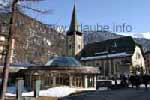
During the winter season, the place for winter sports Zermatt has a complete different charm than all other winter sport places that I have seen until now. In the winter sports places I know, there is normally a typical routine of the day that is, in the mornings between 8.00 and 9.00 a.m., a strong atmosphere of departure in direction to the lifts, that during the day, the place or village is deserted and not until the afternoon around 04.00 p.m., there is slowly some life coming up again in the place, when the first skiers come back from the piste for the après-ski. In Zermatt, I experienced the daily life completely different as in any other winter sports resort before. The matutinal atmosphere of departure in direction to the gondolas and ski busses is spread in a much larger period of time, yes, almost up to the noon time. During the day, there is hustle and bustle caused by vacationers and local people in the car-free Zermatt, as one is used of a German little city. The first skiers and snowboarders already come back in the early morning from the piste, the last ones arrive in the late evening. 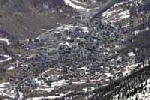
What is different in Zermatt? Why isn't the place during the day not so deserted as the other ski resorts in the winter? It is the audience that makes the difference. While in many other winter sports resorts there are numerous cracks and ski adicts that want to spend the most possible time on the piste, in Zermatt, 99% of the visitors are permanent vacationers that book a whole week straight away. They are also not the kind of vacationers that go on ski vacation 5 times a year, but those that limit their winter sports activities in one or two holidays. On one hand, such people have not the neccessary fitness for being non-stop 7 days on the piste and on the other hand, they are the kind of vacationers that do not only travel for skiing or snowboarding. Thus, there are many Zermatt vacationers that limit their daily descends to a few hours. And many have for one or two days a full break of winter sports, in order to stay in the resort. Thus, Zermatt is a winter sports resort where almost only vacationers travel to. Daily tourists and week-end tourists are very rare; therefore, Zermatt is much too expensive and the journey to get there is much too long. 
Thus, in the place Zermatt, there is a lot of life during the day. The shops are all open and are highly frequented, the restaurants and coffee bars are busy in the afternoons, and the little streets are full. This is pleasant, specially if one joins to this and also take a day off or at least an afternoon in order to get introduced to Zermatt. Zermatt is also much too beautiful to simply walk the way to the gondola station and the way back from it. It is a special place where there is a lot to discover and to visit. What I already enjoyed a lot during the summer, was in the winter time again a great pleasure: it is funny to sit in a coffee bar or restaurant in the Bahnhof-street and watch the people passing by. The mix of people is motley who are carring some skiers or a board under their arm, tourists in high heels or even in suits, and even local people turning with their inline-skates through the people. I think that in Zermatt, I saw for the first time inline-skaters in airy clothes and snowboarders with winter clothes right beside each other. The climate of Zermatt in the winterZermatt is located at a height of more than 1600 m and therewith, it is a winter sports resort situated at a significant height. Thus, what can expected in the winter, when one travels to a mountain resort at such a height? Frozen streets covered with snow, perished coldness, cold winds, huge snow mountains at the left and right side of the street, white mountains as far as the eye can reach and of course also a lot of snowfall and continuously new snow. But noway! 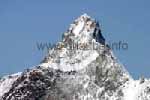
On the Entry Page, I already wrote that with only 700 mm rainfall per year, Zermatt belongs to the areas with the lowest rainfall in Switzerland. This is, among other reasons, due to the fact that Zermatt is well protected by the high four-thousanders, so that there is indeed a lot of snowfall in the nountains but only few in the valley. Thus, at the Monte Rosa Summit for example, there are, with 4100 mm rainfalls per year, more rainfalls that in almost all other places in Switzerland. This is, of course, an ideal combination, a winter sports resort in which there are only few rainfalls and snowfalls, with mountains on which a lot of snow falls every year. 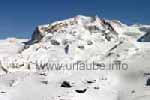
By observing the climate of Zermatt in the winter, one should, of course, not forget the situation of the place. Zermatt is located at the very south of Switzerland, right at the border of Italy. Thus, the German weather forecast does not apply at all for Zermatt any more, even the Swiss weather forecast does not apply directly to Zermatt. Zermatt gets some of the southern Mediterranean air, so that there is, as in the summer time, an outmost mild climate in the winter. Thus, while in the late winter months March and April there is still the hibernal coldness in some other winter sports resorts, in Zermatt it is already possible to enjoy one's afternoon coffee outdoors during this season. The ski area of ZermattI already mentioned above that Zermatt has a huge ski area. On second thought, there are actually in Zermatt four ski areas that are connected and for which there is only one ski pass needed. Not long ago, there were three independent ski areas in Zermatt, that even were in competition to each other. The four ski areas of today are: Sunnegga-Rothorn, Gornergrat-Riffelberg, Klein Matterhorn-Glacier, Breul-Cervinia. 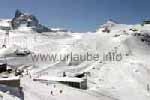
From Zematt there are three valley stations that take one up to the ski areas: at the main station of Zermatt, one can take the Gornergratbahn up to the Gornergrat at a height of 3089 m. The Sunnegga-Express takes one to a height of 2288 m and from there, it also continues up to the Rothorn at a height of more than 3100 m. A further gondola leads up to the station Schwarzsee (2583 m) and/or to the Trockenen Steg (2939 m), from where it continues up to the Klein Matterhorn at a height of more than 3800 m. 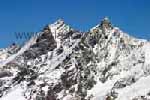
The trip with the Gornergratbahn is surely the most romantic and interesting trip upwards. But the trip from the station over Findelbach, Landtunnel, Riffelalp, Riffelberg, Rotenboden up to the Gornergrat takes a three-quarter of hour. One indeed sits comfortably like in a train, but the trip is quite long, as the railway slowly ascends the 1500 m altitude. The advantage of the Gornergratbahn is that it takes one the whole way up at once, so that after getting out of the train, there is immdiately a long descend. In the Gornergrat-Riffelberg ski area there are only few ski lifts; one rather descends to each of the Gornergratbahn stations in order to get up again by train comfortably. On the ski pistes down to the Gornergrat it oftenly occurs that one has to pass under the railway line in the tunnel - this is also not usual in a ski area! 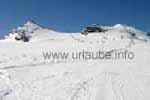
What is clearly faster is the Sunnegga train, that takes one up at a height of 2288 m in 5 - 10 minutes. But in the Sunnegga Express, there is only room for standing. Simirlarly fast is the eight-passenger gondola in direction to the Schwarzsee or to the station Trockener Steg. The railway choosed to get up specially depends on the place were one lives. Actually, all people in Zermatt have a railway close to the living place, that can comfortably reached on foot. For all other, there is the cost-free electric bus that takes one in the morning to the desired valley station and back at the evening. It is even more comfortable with one of the many taxis bidding for the customer's preference. For only a few francs, they take one from the lift station to the hotel. 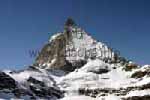
I never saw something like queues at the trains of Zermatt. Due to the reason that the in the mornings, the flow of visitors spreads over three different valley stations for a larger time period, there are practically no queues at the trains. The same also apllies for the lifts in each of the ski areas where normally, there are no waiting times, not even during the main season. The only station with longer waiting periods is the gondola from the station Trockener Steg to the Klein Matterhorn, but this is, as known, the highlight of the ski area of Zermatt, everyone has to get there once. But more about this in the next chapter. 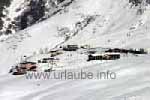
I was generally enthused about the emptiness of the pistes. I have never seen in a ski area during the main season such free pistes as I did in Zermatt. Here, one can really let our steam and also as a carver, one finds the neccessary space to do some wide curves. The reason for the relatively empty pistes are on one hand due to the size of the ski area of Zermatt, on the other hand due to the visitors, that firstly do not go every day to the piste and secondly do not ski the whole day through. But I find that the most sensational piste is the carving-piste from the Theodul Glacier down to Furgg. On this so-called Matterhorn-route, in the sense of the word, one drives right at the bottom of the Matterhorn. A nicer piste can't be imagined. The views are breathtaking, as on this route one is quite lonely. At the first time, it is hard to imagine that something like this is possible at all. One feels like a lonely tour skier at the bottom of the famous summit. 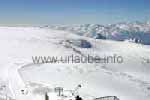
What is still to mention is the ski area at the Italian side, that can be experienced for a little extra charge. During the descen of the glacier one suddenly comes across a signpost where it goes to Italy at the left and at the right to Switzerland - this is also not common for a ski area. In order to descend all ski areas, one really needs to have a full week holiday and even then some valley descends remain unexplored. What I already experienced in the summer applies also for the winter, of course: there are some restaurants, where one is really spoiled with some first-class Swiss delicacies, for example the Fluhalp underneath the Rothorns. These huts can be partly reached on the normal way downwards, but partly, a little swerve must be made. Most of the times, one enjoys a fascinting view from these huts to the surrounding mountains and to the ski area. And, of course, there is nothing nicer than lying in the sun after a good meal in order to get some winter tan. The Klein Matterhorn in the winterWhat is already an absolute highlight in the summer time, of course also applies for the winter. From the station Trockener Steg (2939 m), a gondola leads to the station Klein Matterhorn at a height of 3820 m. >From there, one gets through a tunnel to the ski area and by a lift to the 3883 m heighted observation deck of the Klein Matterhorn. Everybody that spends the ski holiday in Zermatt should at least ascend once the summit of the Klein Matterhorn, as the views are unforgettable and unique. 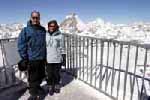
But in the euphoria of skiing and the view, one easily forgets that it is nothing common for the human body to ascend in less than one hour from a height of 1600 m to more than 3800 m, as walking in ski shoes and with a board under the arm means an additional burden. It is better not to go the trip to the Klein Matterhorn at once but first to make some descends in the ski area before ascending the highest summit. Myself, I had to witness how a young American lady collapsed during the exit of the gondola at a height of 3820 m and had to be attended. Thus, there is to be careful with a fast ascending, as the stairs to the observation deck are also a burden for the circulation. 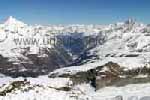
But those who are so lucky to ascend the observation deck of the KleinMatterhorn on a clear winter day, are rewarded with views that will not be forgotten for a lifetime. One does not know where to look first at, to the proximity or to the distance. In the proximity, there is the most famous peak of the world to gaze at, the Matterhorn (4478 m), the highest peak of Switzerland, the Dom (4545 m), the highest peak of Italy, the Dufourspitze (4634 m) and many other famous four-thousander summits. By looking to the north, one can look up to the Berner Alps and the famous summits at the Aletsch-Glacier as the Eiger, the Mönch, the Jungfrau and the Aletschhorn are visible. By viewing to the south, one finds the famous mountains as the Gran Paradiso and of course the highest summit of the Alps, the Mont Blanc (4807 m). But the Mont Blanc seems to be in one's grasp, but there are still some valleys and mountain chains between the Klein Matterhorn and the roof of the Alps. 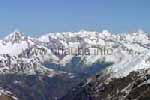
One can actually stay for half an hour on the observation deck of the Klein Matterhorn and firmly save the dream views in one's mind, until the coldness forces one to get down, as also during a nice warm winter day, the temperature is often below -20°C at a height of 3883 m. What then is waiting for one is one of the longest ski descends that can be imagined. From a height of 3800 m, one can descend at once up to Zermatt, thus, one travels an altitude difference of approximately 2200 m. But one does not have to descend up to the valley, the descend from the Klein Matterhorn down to the Theodul Glacier and further downwards to the station Trockener Steg is already unique and a huge enjoyment. The pistes nearly seem to e endless. The gondola trip up to the Kleinmatterhorn is not always linked to waiting periods for nothing. Conclusion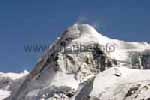
A ski holiday in Zermatt is an unforgettable experience. One lives in a fabulous, car-free place, where the pedestrians have the right of way on the streets. One has a huge ski area with countless pistes and lifts, in which one practically never has to wait and there is always much space for joyfull descends. The ski area is also specially attractive because one does not glide on any kind of pistes between any kind of mountains, but this way, one is close to such famous peaks as the Matterhorn, the Dom, the Monte Rosa and the Breithorn. Thus, one is much more busy with sightseeings as somewhere else. 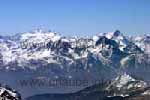
Zermatt is, by the way, a ski area during the whole year, thus, it is also possible to do one's swings in the afternoon on the glacier during the hot summer months. In the winter time, Zermatt has an absolute snow guarantee and due to the Mediterranean influence, a high probability for good weather. In order to spend the winter holiday in Zermatt one should take a full week time, as the trip to the most southern end of Switzerland is long and takes a long time. Additionally, there is a railway trip from the valley place Täsch up to the car-free Zermatt to do. As said, a winter holiday in Zermatt is something uncommon and unforgettable. It is obvious that such a holiday is not cheap. This is already noticeable in the hotel rates or the menue card of a restaurant. Also the ski pass is more expensive in Zermatt as in other ski areas. This is why during the booking of a journey to Zermatt, one should without fail look at some complete offers at a good price offered by the hotels, as for example 7 days accommodation with half pension included and a ski pass. With such offers, one partly saves umpteen percent as by booking and/or buying everything separatedely. 
Copyright: Patrick Wagner, www.tourist-guide.biz |
||